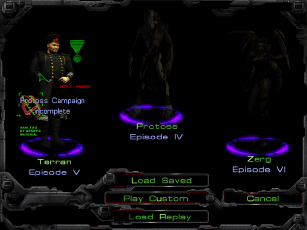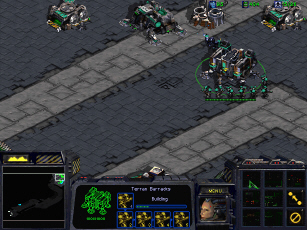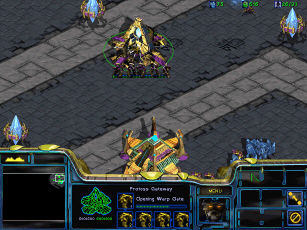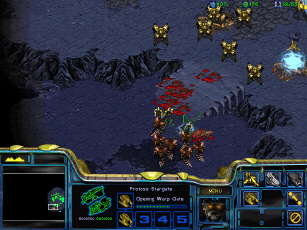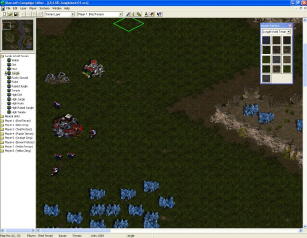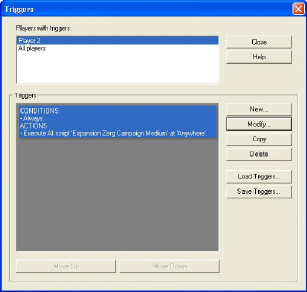|
|
||||||||
ONE NOMINATION REASONS WHY STARCRAFT MIGHT BE THE BEST REAL TIME STRATEGY GAME EVER
Real time strategy [RTS] games form a crowded genre, so picking the best of all time is something that does not call for picking a winner by default, or damning one by faint praise while just damning the rest. In my gaming experience, two from Microsoft have been veritable time vacuums over the years: Age of Empires II: The Age of Kings and Rise of Nations, with their respective expansions The Conquerors and Thrones and Patriots. If pressed to nominate one, and only one game, my attention would go beyond Microsoft, to Blizzard Entertainment. Today best known for its World of Warcraft fantasy massive multiplayer online game, which doubles as an engine of massive commercial success, Blizzard publishes two older games that, though about a decade old, retain the power of suck in time and generate a lot of addictive fun in the process. Though not the newest title in its franchise, as Warcraft III followed it and preceded World of Warcraft, Warcraft II is an essential fantasy RTS game. Like the Microsoft games, its introduction has been a frequent funeral oration for productive time. Pressed for that one best game of all, my nomination goes to Blizzard's enduring science fiction game, StarCraft. Most computer games start to show their age in a year or two, and this might not have been more true than in the late nineties, when StarCraft was unleashed on the gaming public. Moore's Law gave a minimum standard for the pace of hardware improvement, and DOS, one of the most stable operating systems for the personal computer but also one of the worst for gaming, gave way to a succession of 32-bit Windows platforms. Under those circumstances, one might expect games from 1997 to have a fast track to the dustbin of obsolescence. History proves otherwise, as a succession of late-nineties titles retain their popularity, often in updated and reissued forms: Matrix Games has a happy history with turn-based strategy games from the era, including John Tiller's Campaign Series, The Operational Art of War and two flavors of Harpoon. StarCraft survives not in a recoded, updated form, but as it was originally published, with patching that it actually less extensive than in many new games. One can still buy a StarCraft "Battlechest," which includes the Brood War expansion, and find it virtually the same product that one might have purchased ten years ago. Ten years is an eternity for software, and yet StarCraft retains its claim as one of the very best RTS games in software history. The reasons lie in excellent concepts, skillfully executed. WHEN SPECIES COLLIDE The foundation of StarCraft's excellence is its background. There are three campaigns in the game, for each of the combatant races, with three more in the Brood War expansion, along the same lines. They provide some memorable moments, with the most famous perhaps an animation in which human soldiers find a carcass of a strange-looking alien, threatening in appearance but small and quite dead. Then a bigger, nastier one shows up to end their curiosity along with their lives. Those beings are members of the Zerg, one of the most creative alien races in science fiction gaming, and probably in science fiction of any variety. They start live as larvae, which can metamorphise into worker drones, or into more belligerent types, with nasty teeth, claws, and other weapons not usually associated with biological entities. Some bear a passing resemblance to the creatures in the Aliens movies. Others call to mind the vicious monsters that live in the darkness of Vin Diesel's breakthrough film, Pitch Black. In general though, any resemblance is a start, not the end, of its identity. Zerg drones can change further into the species' equivalent of buildings. Alone among the races in StarCraft, the Zerg do not build; they become. The Zerg have a limitation that meets the conventions of RTS gaming. Usually, populations have to be supposed by houses or some other support structure. If the player wants to grow his population, he has to grow his infrastructure with it. The Zerg need overlords for this purpose, just Terrans in the game need supply depots. The difference is that the overloads float, albeit slowly. They have a reconnaissance function, though even a ground unit can can usually run down and destroy the lumbering gasbags. What is unconventional is that they can build, if build is an operative word, on "creep." Creep is a kind of gradually-spreading purple mass that looks a little like scaly vomit and a lot like a cancerous lesion. Only two Zerg structures can be built elsewhere, vespene gas extractors and the hatcheries at which colonies begin. The second alien race is the Protoss, humanoids with a difference. They do not build either, but teleport units and buildings on the planet that they colonize, drawing power from pylons. These structures not only support populations, as overlords support the Zerg. Most Protoss structures have to warp into the effective radius of a pylon, so that they provide what might look like a kind of "virtual creep." Basically, if there is no pylon nearby, there are almost no Protoss buildings that can enter the game there. The Protoss have their own distinctive units. At the lowest levels, combat units have names such as "high templar" and "dark templar," which can eventually combine to become archons and dark archons. The nomenclature is indicative of a more militantly spiritual, or pseudo-spiritual, outlook. They also have a certain dignity, which would be apparent even if the other aliens were not intelligently-directed tumors. Another combat unit is the carrier. As the name indicates, it is a kind of aircraft carrier, but one that flies. The Terrans are the human power in the game. More than just a control group against which one can measure the aliens. They fit the mould of colonists and space marines that ones sees in Aliens, and to some extent the future history in Jerry Pournelle's novels. Any resemblance to Star Trek and its universe though is tenuous and strictly accidental, as if they have a five-year mission to do anything, it is to break things and kill aliens, not pursue peaceful understanding. If there is a prime directive, it is to kill any moving competitor. Human combat units reflect familiar norms of warfare in historical times. The basic ground pounder unit is the marine, and there are siege tanks, which are more like self-propelled artillery, and space ships with familiar names such as science vessel, valkyrie frigate and battlecruiser. The basic conceptual familiar of the Terrans, despite the science fiction background of StarCraft, makes them the most accessible and perhaps the most easy side to play. The Protoss are more alien, and the Zerg the weirdest of all. That makes them the most challenging of the three. INTELLIGENCE THAT IS INTELLIGENT Artificial intelligence in RTS games can be one of the more prominent problems. For all of its other appeal, Age of Empires II suffers from some of the easiest and most predictable programming, at least until the setting passes the midway point. In Rise of Nations, and the Real War series especially, artificial intelligence has a completely different issue, and one that works out to be even more maddening. An old, anonymous adage states that the problem with life is that you cannot win, you cannot break even, and you cannot quit the game. These games' approach to artificial intelligence gives lie to it, by making sure that you cannot win, but you can break even, and not do any better. They often degenerate into frustrating stalemate. In such cases, the artificial intelligence might look tough, at least on a superficial level, but its difficulty is of a type that cuts enjoyment. Spending untold hours trying to get a slight edge that might get the player a little closer to victory is not fun for most people, any more than World War I trench warfare provides scintillating strategic scenarios. The artificial intelligence in StarCraft is neither a programmed idiot, nor predestined frustration. It is usually extremely challenging, and a careless player will lose. A careful and competent one often will too. There are two variables in an RTS's artificial intelligence, one obvious and the other less so, and StarCraft shines at both. The first is the "skill" of the computer. Does it make good decisions? In an RTS game, that means optimally collecting resources, building assets, and then conducting military as well as economic strategy. It is the quality that one seeks in any computer computer game. The other is aggressiveness. A side can be as smart as possible, usually in the economic sphere, but the artificial intelligence diminishes if it stays around its base. If nothing else, it becomes predictable. Then it becomes easy. Having a computer-controlled power take the offensive enhances the game. Some are deficient in this area. Again, the Age of Empires series could be better, and computer-controlled allies of the player's civilization are especially timid. There are few opportunities to accuse StarCraft's programming of timidity. An already sophisticated artificial intelligence system tends to become a computerized pit bull, particularly in scenarios with random opponents. Computer-controlled enemies go on the attack early, try to preempt the player in the staking claim to resources, and go after one's base at the earliest opportunity. Since the software does an excellent job at managing resources, and translating them into military power. such aggressiveness hurts. If there is room for criticism, is it that the artificial intelligence is too good at its mission. In addition, StarCraft has no controls for adjusting the level of difficulty; the only way to do that is to go into the scenario through the editor, and save it, perhaps under a new name, with a different artificial intelligence script. THE EDITING ROOM Today, most games come with some sort of editor, and the same held true in the late nineties. As with the games themselves, the editors are quite variable in their quality. The "Campaign Editor" to StarCraft is very good for altering existing scenarios or building them from the ground up, literally. The designer chooses one of eight environments, and builds up from there. Most are natural, but the installation and space platform represent artificial worlds. Next, the designer overlays terrain features. For the most part, this is extremely easy, a matter of pointing and clicking to put hills, mud, lava, water, and other basic terrain on the foundation. Some are slightly more difficult, requiring a little more skill and practice, bridges especially. The scenario designer has to match both sides of the bridge to the terrain on either side of the gap exactly, or the attempt will fail. Thus there is no room for trial, let alone error, nor can one place the bridge on one side as a bridge to nowhere, and then build the land on the other side to match up to it. Placing resources is just as easy. Vespene geysers come in just one variety and mineral fields come in three, and even then all the differences are strictly cosmetic. There is no need for the player to measure the value of either, as when it comes to function, all are created equal. The terrain layer allows for another type of neutral feature, critters. In the Age of Empires series, wild animals can be hunted for food, or they go into bad moods and chase down human characters, often with unpleasant results. Those in StarCraft tend to just move around a lot, and are best left alone. "Doodads" constitute their own layer, and are similar but stationary. They are static ornaments, things such as vegetation, wrecks, ruins and dead things. Adding them does nothing to enhance the functionality of the scenario, but does make it look a lot better. Adding units through their layer is no more difficult than working with terrain. Select, point and click. One can further manipulate upgrades and even add power-ups to the map. The most powerful, necessary, and difficult, part of designing a scenario is adding triggers. Just starting off with a set quantity of resources requires a trigger. So does giving the players briefings about the general strategic situation. The most important use of triggers is giving the computer-controlled side or sides something to do. Without them, these units stand around their bases, doing nothing except waiting for death at the hands of the player, and this certainly presents neither challenge nor enjoyment. Therefore the scenario designer has to insert at least one trigger for each computer-controlled power, establishing the difficulty level of that side's artificial intelligence. Since StarCraft's editor allows one to differentiate between the locations where triggers occur, the basic location for this script is the all-encompasing "anywhere." However, a creative scenario designer can alter this too, by making a power tougher around its home base, for example, and then designating outlying locations where it might become, shall we say, more developmentally-challenged. A designer has a great deal of freedom with triggers, giving any side bonuses or penalties, or changing the course of the game, in the course of events. Exploring the possibilities can be as fun for designers as it is surprising for players. SHORTCOMINGS Perfection is elusive, and despite StarCraft's many impressive accomplishments, it does not appear in this game. Not even by 1998 standards. The difficulty in changing difficulty settings is an obvious shortcoming, regardless of era. StarCraft's difficulty can only be changed through the scenario editor, making it much more complicated for players to adjust to their skill levels than almost any other computer game. This is an exchange though; as an examination of the scenario editor shows, difficulty in StarCraft can be a much more complex concept than in other titles, especially its contemporaries. Connected with this, establishing the fundamental behavior of computer-controlled units is the most difficult part of designing a scenario. Usually, when one designs a scenario in a computer game, by default the computer-controlled forces will do something in their own interests, whether it is collect food or defend themselves. StarCraft's are outstanding in their passivity. Furthermore, inserting the artificial intelligence scripts is not the intuitive process in the software, and finding out how to do it is almost hidden in the help files. In a game in which the technical and creative standards remain highly impressive, this is one of the most galling errors, and probably the one that should have been corrected before publication. If the software is going to call upon the users to do something extra, it should at least make the task obvious and easy. In ten years, personal computers have benefited from all the progress of Moore's Law. Along with processing power, graphics capabilities have progressed too. One might think that StarCraft would play as readily on a current computer as it did on the state of the art hardware when it was first published. Moore's Law is a law. Backwards compatibility is not. Getting it to run on Windows XP, let along Vista, takes some effort. One should download the latest patch from Blizzard's site to start. Then, since StarCraft does not appear to get along well with others, all other programs should be closed. Second, StarCraft has a tendency to run in colors that not intended by the developers or by nature; for example, black gives way to purple, and there is weird flashing, neither of which was a problem in the late nineties. The best way around that is to right click on the shortcut that starts StarCraft, and choose Properties. Select the Compatibility tab. One should always fill the Run in 256 Colors box under Display Settings, and also Run in 640 x 480 Screen Resolution. Disable Visual Themes might help too. Finally, repeat the process for the Brood War shortcut. I find as well that the game runs better if I start it from the CD autorun shortcuts and not from those on the Start menus. CONCLUSIONS From a technical standpoint, StarCraft is showing its age. The graphics were stunning in 1998, and though they look pretty good today, the flash is gone, even if one can get them to display correctly. The world of computer gaming needs a new version of StarCraft for no other reason than to have something that plays well, without headaches. Fortunately a StarCraft II is now under development at Blizzard. Hopefully it will bring the technology of the original into the twenty-first century, while retaining the magic that makes StarCraft one of the best RTS games in the history of the genre, if not the very best. Meanwhile, it should be remembered that what makes StarCraft special is not bleeding edge technology. It is the basics, the elements that go into the foundations of any good creative work. The game starts with a compelling story and species. In the latter, one is our own, and the other is unforgettable because it threatens us on our deepest level, even more so than reptiles or arachnids. If you have seen a tumor or lesion, you have seen what makes the Zerg memorable. The second element is that the game presents a constant challenge. It can be too difficult at times, but never too easy, and never engineered to produce a stalemate. StarCraft may kill you, but never with frustration. Lastly, it presents opportunities for the players to continue the creativity begun by the developers. The scenario editor has some shortcomings, specifically for programming computer-controlled behavior, yet just about everything else is easy and intuitive. It is up to history to determine if StarCraft is the best RTS game so far. It certainly deserves a nomination though, and for that purpose is thus is presented for your consideration.
|

